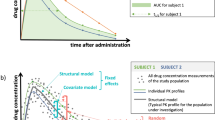Abstract
This paper presents the analysis of the kinetics of a new antihistamine, mizolastine, in 18 healthy volunteers, from concentrations measured after an intravenous infusion and two different oral administrations: tablet and capsule. Two approaches were used to analyze these data: (i) a noncompartmental approach implemented in PHARM-NCA: (ii) a compartmental modeling approach implemented in a new S-PLUS library. NLS2, 5 which allows the estimation of variance parameters simultaneously with the kinetic parameters. For the compartmental modeling approach, two-compartment open models were used. According to the Akaike criterion, the best model describing the kinetics of mizolastine after oral administration was the zero-order absorption model. The kinetic parameters obtained with PHARM-NCA and NLS2 were similar. The estimated duration of absorption was greater for the tablets than for the capsules (with means equal to 1.13 hr and 0.84 hr respectively). After an intravenous infusion, the mean estimated clearance was 4.9 L/hr, the mean λ 2 -phase apparent volume of distribution was 89.6 L and the mean terminal half-life was 12.9 hr.
Similar content being viewed by others
REFERENCES
P. Rosenzweig, J. J. Thebault, H. Caplain, C. Dubruc, G. Bianchetti, E. Fuseau, and P. L. Morselli. Pharmacodynamics and pharmacokinetics of mizolastine (SL 85.0324), a new nonsedative H1 antihistamine. Ann. Allergy 69:135–139 (1992).
T. Hulot, G. Bianchetti, V. Ascalone, L. Flaminio, M. Picard, and P. L. Morselli. Absolute bioavailability and absorption kinetics of a new benzimidazole derivative, mizolastine, in healthy volunteers. Eur. J. Drug Metab. Pharmacokin. 18:36 (1993).
PHARM-NCA, Noncompartmental Pharmacokinetic Data Analysis Software, release 1.3e, SIMED SA, Créteil, France.
M. Rowland. Intra-individual variability in pharmacokinetics. In D. D. Breimer (ed.), Towards Better Safety of Drugs and Pharmaceutical Products, Elsevier/North-Holland, Amsterdam, The Netherlands, 1980.
C. Dubruc, P. Chrétien, G. Bianchetti, J. P. Thenot, and P. L. Morselli. Inter-and intra-subject variability of the pharmacokinetic profile of mizolastine in healthy young volunteers after a single 10 mg oral administration. Eur. J. Drug Metab. Pharmacokin. 18:118 (1993).
M. O. Karlsson and L. B. Sheiner. Estimating bioavailability when clearance varies with time. Clin. Pharmacol. Ther. 55:623–637 (1994).
J. G. Wagner. Biopharmaceutics and Relevant Pharmacokinetics, Drug Intelligence Publications, Hamilton, 1971.
A. Bouvier and S. Huet. NLS2. Nonlinear regression by S-PLUS functions. Comput. Stat. Data Anal. 18:187–190 (1994).
V. Ascalone, P. Guinebault, and A. Rouchouse. Determination of mizolastine, a new antihistaminic drug, in human plasma by liquid-liquid extraction, solid-phase extraction and column-switching techniques in combination with high-performance liquid chromatography. J. Chromatog. 619:275–284 (1993).
J. G. Wagner. Fundamentals of Clinical Pharmacokinetics, Drug Intelligence Publications, Hamilton, 1975.
M. Gibaldi and D. Perrier. Pharmacokinetics, Marcel Dekker, New York, 1982.
S-PLUS User's Manual, Statistical Sciences, Seattle, 1991.
S. Huet, A Bouvier, M. A. Gruet, and E. Jolivet. Statistical Tools for Nonlinear Regression: A Practical Guide with S-PLUS Examples, Springer-Verlag, Berlin, 1996.
H. Akaike. A new look at the statistical model identification. IEEE Trans. Automat. Contr. 19:716–723 (1974).
T. L. Ludden, S. L. Beal, and L. B. Sheiner. Comparison of the Akaike Information Criterion, the Schwartz criterion, and the F test as guides to model selection. J. Pharmacokin. Biopharm. 22:431–436 (1994).
J. D. Gibbons. Nonparametric Statistical Inference, McGraw-Hill, New York, 1971.
S. Holm. A simple sequentially rejective multiple test procedure. Scand. J. Statist. 6: 65–70 (1979).
W. R. Gillespie. Noncompartmental versus compartmental modeling in clinical pharmacokinetics. Clin. Pharmacokin. 20:253–262 (1991).
K. E. Fattinger and D. Verotta. Estimating bioavailability when clearance changes in time: The effect of model misspecification. Clin. Pharmacol. Ther. 58:595–600 (1995).
M. O. Karlsson and U. Bredberg. Estimation of bioavailability on a single occasion after semisimultaneous drug administration. Pharm. Res. 6:817–821 (1989).
P. S. Collier and S. Riegelman. Estimation of absolute bioavailability assuming steady state apparent volume of distribution remains constant. J. Pharmacokin. Biopharm. 11:205–214 (1983).
Y. Kasuya, T. Suruta, H. Shibasaki, and H. Shimota. Evaluation of the utility of a proposed method for correcting for intrasubject variability in metabolic clearance in the bioavailability assessment of the theophylline. J. Pharmacokin. Biopharm. 19:113–116 (1991).
S. D. Hall, C. B. McAllister, and G. R. Wilkinson. The assessment of bioavailability in the presence of nonlinear elimination. J. Pharmacokin. Biopharm. 16:263–278 (1988).
M. O. Karlsson and U. Bredberg. Bioavailability estimation by semisimultaneous drug administration: A Monte Carlo simulation study. J. Pharmacokin. Biopharm. 18:103–120 (1990).
M. Davidian and D. M. Giltinan. Nonlinear Models for Repeated Measurement Data, Chapman and Hall, London, 1995.
R. J. Carroll and D. Ruppert. A comparison between Maximum Likelihood and Generalized Least Squares, in a heteroscedastic linear model. J. Am. Statist. Assoc. 77:878–882 (1982).
L. B. Sheiner and S. L. Beal. Pharmacokinetic parameter estimates from several least squares procedures: superiority of extended least squares. J. Pharmacokin. Biopharm. 13:185–201 (1985).
D. M. Giltinan and D. Ruppert. Fitting heteroscedastic regression models to individual pharmacokinetic data using standard statistical software. J. Pharmacokin. Biopharm. 17:601–614 (1989).
A. Messéan. A generalization of Gauss-Marquardt algorithm for exponential families problems. Comput. Statist. Quart. 4:79–88 (1988).
Author information
Authors and Affiliations
Rights and permissions
About this article
Cite this article
Mesnil, F., Dubruc, C., Mentre, F. et al. Pharmacokinetic Analysis of Mizolastine in Healthy Young Volunteers After Single Oral and Intravenous Doses: Noncompartmental Approach and Compartmental Modeling. J Pharmacokinet Pharmacodyn 25, 125–147 (1997). https://doi.org/10.1023/A:1025775912051
Published:
Issue Date:
DOI: https://doi.org/10.1023/A:1025775912051




